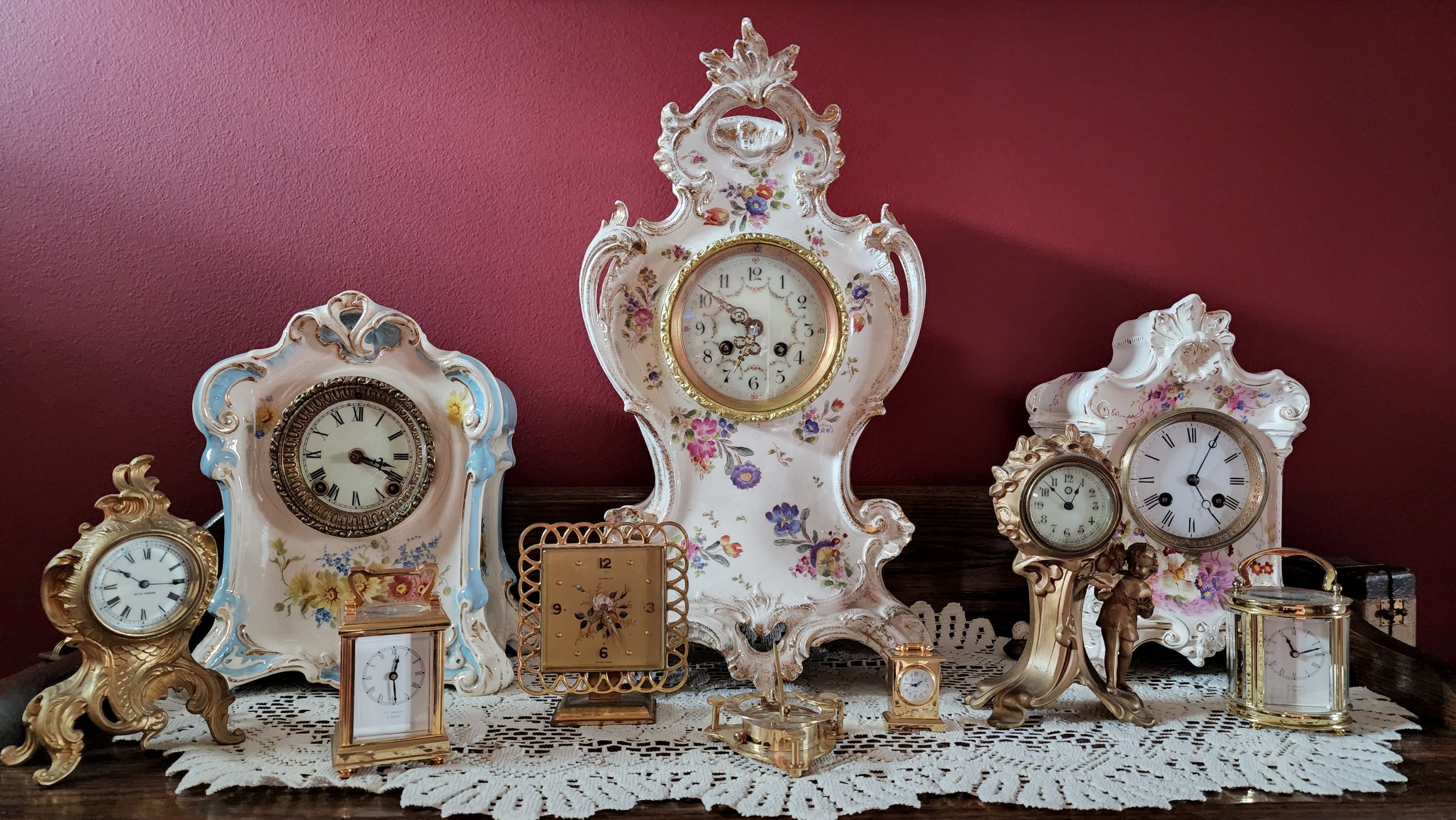
Interesting Clock Facts

When is a clock not a clock?
When it’s a timepiece. The word “clock” was derived from the Dutch word “glock” which means bell. The term clock was then applied to those timepieces which “struck a bell”. Therefore “clocks” that do not strike or chime are technically called “timepieces”.
What do the words “Tempus Fugit” mean on a clock dial?
Many people mistake these words for the brand name of their clock, when in reality, it is a Latin phrase which means “time flies”.
Did you know that the Westminster chime has words that go along with the melody?
It certainly does and here they are:
Lord through this hour
Be thou our guide
So by thy power
No foot shall slide.
I have also seen it written this way:
All through this hour
Lord, be my guide
And by thy power
No foot shall slide.
Ansonia China Case Clock
China Case Clock

Latin for “times Flies”

Why do they call Them “grandfather clocks”?
In the earliest days of clock making, the clock’s movement was cased in a small “box” with a dial on the front and was made to be hung on the wall where the pendulum and weights were hanging free in the open air. With nothing to protect the pendulum it could easily be upset by a breeze and the clock would stop. Eventually they began to build cabinets around the pendulum and weights in order to protect them. The cases eventually got longer and longer until these clocks were then able to stand on the floor without being hung and were termed tall case, hall or floor clocks.
The term “grandfather clock” was popularized in 1875 when a song written by Henry C. Work called “Grandfather’s Clock” was published. The song’s title referred to a clock owned by the song writer’s grandfather, which happened to be a tall case or floor clock. It became a very popular song in its day, and the sheet music reportedly sold over 800,000 copies, quite a number in those days. Some of the lyrics were as follows:
My grandfather’s clock was too large for the shelf,
So it stood ninety years on the floor;
It was taller by half than the old man himself,
Though it weighed not a penny weight more.
It was bought on the morn of the day he was born,
And always his treasure and pride;
But it stopp’d short never to go again
When the old man died.
In watching it’s pendulum swing to and fro,
Many hours he spent while a boy;
And in childhood and manhood the clock seemed to know
And to share both his grief and his joy.
For it struck twenty four when he entered the door,
With a blooming and beautiful bride;
But it stopp’d short never to go again
When the old man died.
It rang an alarm in the dead of the night
An alarm that for years had been dumb;
And we knew that his spirit was pluming for flight
That his hour of departure had come.
Still the clock kept the time,
With a short and muffled chime,
As we silently stood by his side;
But it stopp’d short never to go again
When the old man died.
In fact, the song was so popular that a few years later, a sequel was written by the original composer and was titled, “Sequel to Grandfather’s Clock.” In the sequel we are told of the clock’s sad ending. The grandson, upon returning to his grandfather’s house, which is now owned by others, learns of its fate. The clock having not run since his grandfather’s death was traded in for another clock which was hung on the wall in its place. The clock peddler took the clock to a junk shop where its parts were melted down. The case was then chopped into kindling by the junk-dealer’s wife, a sad ending indeed. I guess there weren’t any good clockmakers nearby!
Example of large “un-cased” pin Wheel Regulator
This is a “cased” Pin Wheel Regulator.


Ever wonder why some clock dials with Roman numerals use “IIII” instead of the correct form of the number 4 which is “IV”.
Many early dial makers noticed that within the ring of numerals on a clock dial the Roman number IIII presented a better balance with the roman number VIII on the opposite side. Everyone to come along afterwards must have agreed as this custom has continued to be a preference.
Did you know?
Historically, the ability to measure time with an increasing degree of accuracy has been so great that for centuries, clockwork was by far man’s most sophisticated invention.
The three clocks above all show examples of dials using the Roman number IIII variation

Antique 8 Day Weight
Driven Ogee Clock

Did you know?
What Henry Ford was to cars, Eli Terry was to clocks? Long before Henry Ford began the process of building cars with an assembly line, Eli Terry began to mass produce clocks using similar methods.
Up until about 1805 clocks were costly masterpieces. They were mostly handmade-to-order luxuries for only a wealthy few.
A master clockmaker would make a clock as a model and then his apprentices would use this as a pattern. Manufacturing the parts, one at a time, in this manner often caused the same parts to be slightly different. These minor differences kept the parts from being interchangeable.
Eli Terry shattered tradition by beginning work on clocks for which no one had ordered. He reasoned that in making them in this manner he could produce them cheaper and he would therefore be able to find a broader market for them. Some of his earliest clocks made in this manner sold for about $25. Even these were too expensive for some and he began to sell them on time-payments.
In 1807 Terry shocked a great many clockmakers when he announced that he would begin work on 500 clock movements to be sold at $5. They did not believe it possible. As it turns out, over the next three years he produced 5,000 clock movements.
With this humble beginning, little did Terry know that by 1941, 15,000,000 clocks would be produced yearly in America. (Source, Look Magazine 9/4/45)

Antique white dial

Someone once said,
“Man is uncomfortable with time because he was created for eternity.”






